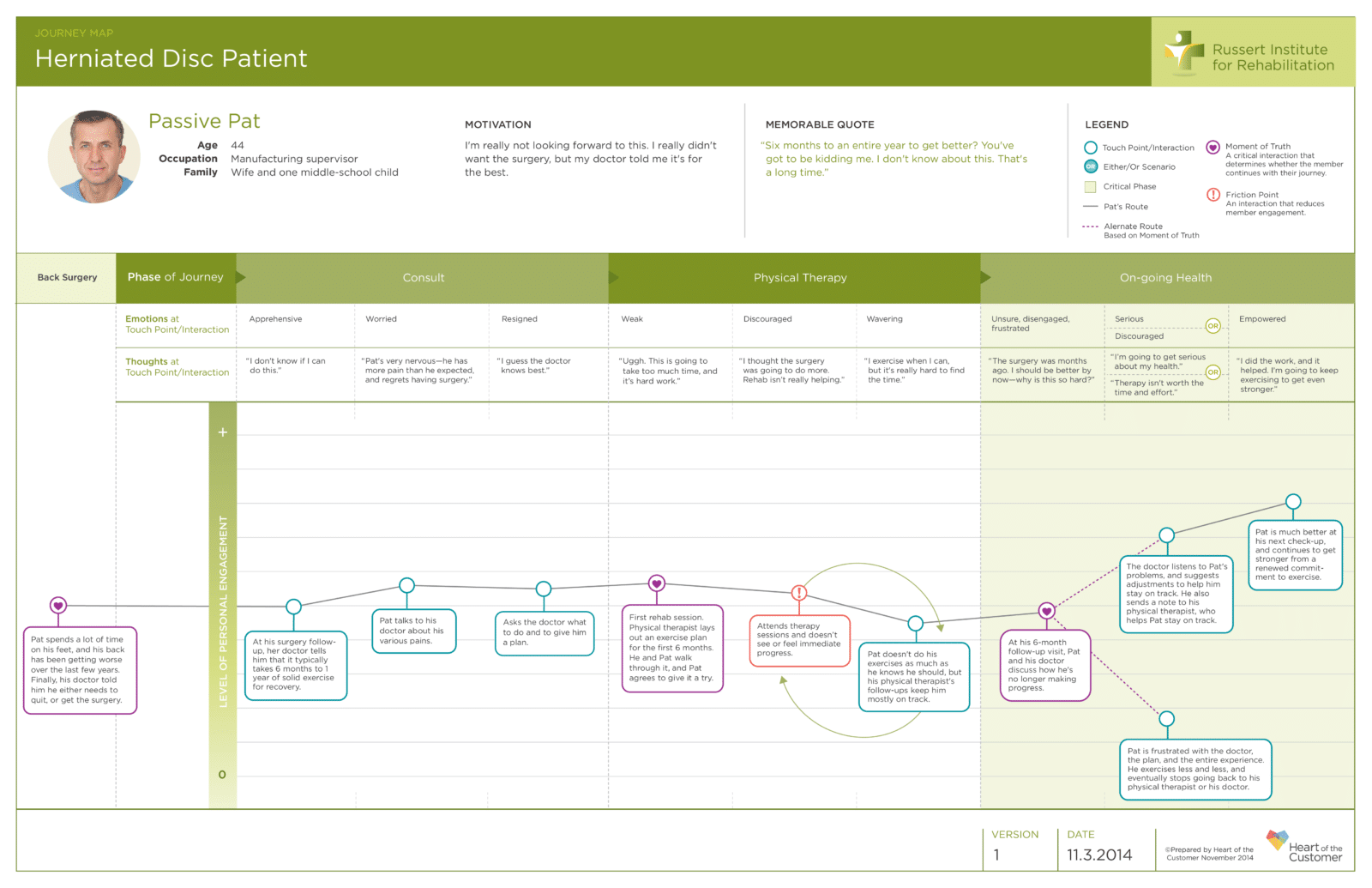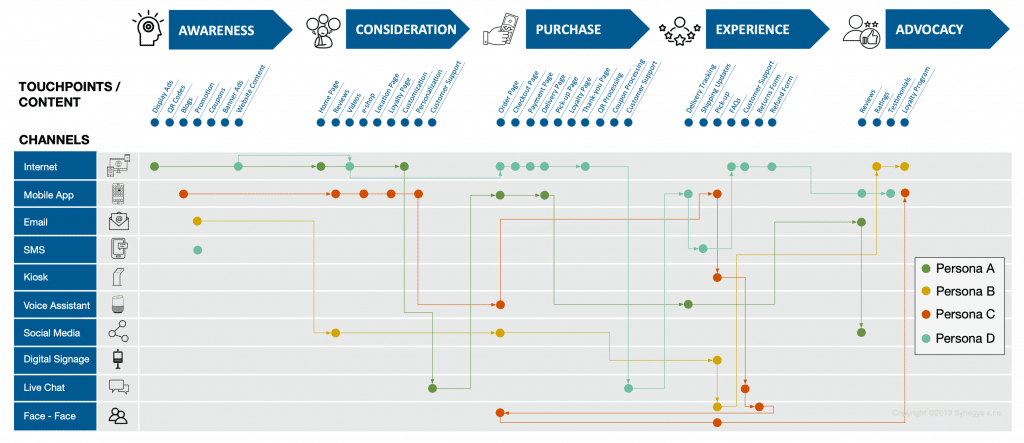Podcast: Play in new window | Download (Duration: 9:30 — 9.3MB)
Subscribe: Apple Podcasts | Google Podcasts | Stitcher | TuneIn | RSS | More
This CX Mini Masterclass explains customer touchpoint maps, how these differ from journey maps, and their place in the CX professional’s toolbox. Show host and customer experience expert, Julia Ahlfeldt, breaks down what a touchpoint map is (and is not) and this tool’s role in helping teams build and manage customer experiences. If you’re interested in learning about touchpoint maps, what they’re used for, and tips on how to build one, then this episode is for you.
The #1 misused term in CX
Touchpoint maps are often confused with journey maps, much to the frustration of CX professionals. In fact, the word “touchpoint” is so frequently misused, that many CX professionals have an aversion to it all together. That said, a good customer touchpoint map can serve an important purpose. These maps help teams understand how a customer interacts with a brand. They can be useful compliments to journey maps, as touchpoint maps can serve as a the link between the outward-looking perspective of the journey map and the inward-looking perspective of a process map or service blueprint.
First off, it’s important to understand the concept of a customer touchpoint, and how this differs from a customer experience. Touchpoints are the conduits for experiences throughout the journey. They are the channel or mode of interaction, not the interaction itself. For example if a customer is on a journey to get medical treatment and one of the experiences is calling their health insurance company to check on the status of a claim, the experience is calling in, and the touchpoint would be call center. To take things a step further, one could break down the specific touchpoint components within the call center like the IVR system, the agent and maybe even the phone connection itself. These would also be considered touchpoints.
Touchpoint map vs. Journey map
A customer journey is the series of events or experiences that a customer has as they are trying to fulfill some need in their life. Sometimes this need is referred to as a “job to be done”. A Journey map is the visual representation of this series of experiences, presented from the customer’s point of view. (If you are at all unsure about the definition of the terms touchpoint, experience or journey map, be sure to check out episodes 14, 15 and 16, which cover these concepts in detail.)
A touchpoint map is a visual representation of the channels of interaction that a customer interfaces with throughout their journey. To understand the touchpoints you have to first understand the journey. And the touchpoint map is the representation of a customer persona’s journey, not all the possible touchpoint possibilities out there (which would be more of a touchpoint matrix). It’s also not the touchpoints that you want the customer to interface with (which would probably be considered a touchpoint design).
It’s easiest to think about the touch point map as a byproduct of the customer journey map. A team will be best-positioned to build a touchpoint map only after they’ve crafted their journey map. Once the journey map is built, a team can then create an overlay of the touchpoints that a customer interacts with, delving into deeper levels of detail as needed.
When considering possible touchpoints, keep in mind that customer journeys don’t happen in a vacuum, they happen in the real world and so they are rarely isolated to interactions with just one brand. As a result, you may want to include touchpoints that aren’t in your control. In the example of the call to the health insurance company, the customer’s phone is an important touchpoint in the journey, even though that isn’t something that the health insurance provider can control.
Putting your touchpoint map to use
Touchpoint maps are surprisingly versatile tools, though most frequently when used in conjunction with other CX artifacts like journey maps and service blueprints. Here are just some of the ways they can be used by CX professionals.
- Validate the volume of customers who are having a specific experience. Touchpoints are where a customer interacts with a company, and these experiences often generate a data trail, so a touchpoint map can be quite helpful for identifying data sources to be used in quantifying the impact of experiences on the customer base.
- Root cause analysis on customer experience pain points. Perhaps the common denominator of several journey pain points is a faulty touchpoint that just isn’t supporting experiences as it should, but this isn’t obvious looking at the journey map. A touchpoint map can be a helpful diagnostic tool because is strips out some of the complexity and lets you hone in on one facet of the experience.
- A reality check for business leaders about how many touchpoints exist and the variation of experiences through different channels. In episode 65, Diego Gabathuler, CEO of Ivoclar Vivadent shared that their journey mapping had yielded more than 200 touchpoints. A touchpoint map can be used to help plan for consistency across channels, perhaps by bringing in standards or experience principles for all touchpoints.
- Fleshing out a service blueprint or the other process documentation that supports customer experiences. Since touchpoints represent the channels of interaction, it’s a logical place to start building the understanding of how an organization supports experiences. Each touchpoint likely has a web of teams, processes and technology behind it. This can be especially useful when it comes time to start translating journey findings into experience improvements.
Want to keep learning about CX?
If you’d like to checkout more of these CX Mini Masterclasses or listen to my longer format CX expert interviews, check out the full listing of episodes for this CX podcast.
Decoding the Customer is a series of customer experience podcasts created and produced by Julia Ahlfeldt, CCXP. Julia is a customer experience strategist, speaker and business advisor. She is a Certified Customer Experience Professional and one of the top experts in customer experience management. To find out more about how Julia can help your business achieve its CX goals, check out her customer experience advisory consulting services (including CX strategy, voice of customer and culture change) or get in touch via email.

